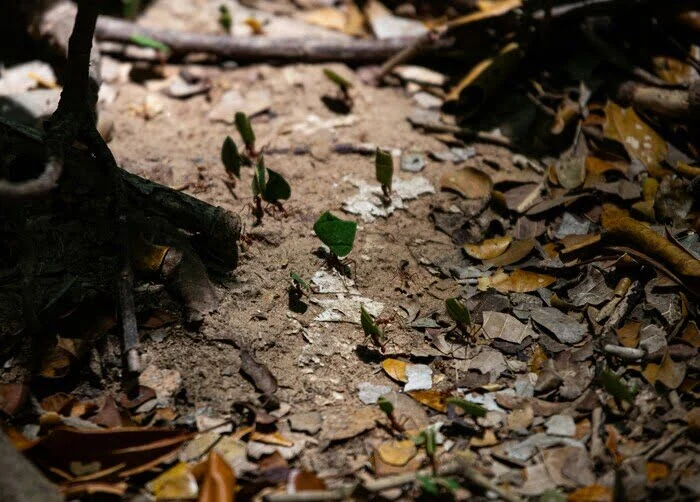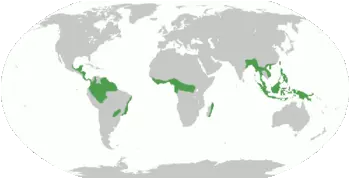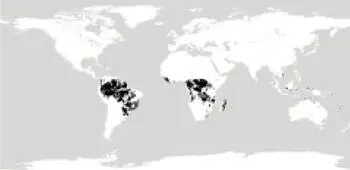Why Are Rainforest Soils So Infertile?
A Deep Dive into the Paradox of Nutrient-Poor Soils in the World's Most Lush Ecosystems

Why Are Rainforest Soils So Infertile? The Surprising Truth | February 27, 2025
Why Rainforest Soils Are Nutrient-Poor and Infertile
Introduction
Tropical rainforests astonish observers with their lush vegetation and biodiversity, yet the soils underlying these verdant ecosystems are famously poor and infertile[1][2].
This paradox has long puzzled scientists: how can some of the planet’s most productive forests thrive on soils that are often thin, acidic, and leached of nutrients? This report explores the factors behind rainforest soil infertility and the global patterns observed across different continents, climates, and terrains. We examine how intense weathering, heavy rainfall, rapid nutrient cycling, and geological history contribute to nutrient-poor soils, and we compare soil characteristics in rainforests like the Amazon, Congo Basin, and Southeast Asia. We also discuss other causes of infertility beyond leaching—such as inherent soil chemistry—and consider the ecological implications for plant and animal life. Throughout, peer-reviewed research and authoritative sources are cited to provide a scientifically rigorous understanding of tropical rainforest soils.
Climate, Weathering, and Leaching of Nutrients

Photo Credit: Public Domain
One of the primary reasons rainforest soils are infertile is the intense climate of the tropics, which drives extreme weathering and nutrient leaching. Tropical rainforests receive abundant rainfall—typically 1,500–3,000 mm (60–120 inches) per year—with rain often spread throughout the year in equatorial regions[2]. This constant high rainfall means the soil is almost perpetually wet, creating a nearly permanent downward percolation of water through the soil profile[1]. As rainwater drains through the ground, it leaches soluble nutrients out of the soil and carries them into streams and rivers. Over time, essential elements like nitrogen (N), phosphorus (P), potassium (K), calcium (Ca), and magnesium (Mg) are washed out of the upper soil layers[1][3]. The result is that underlying soil horizons are left depleted of minerals and nutrients, rendering them relatively infertile[1].
Many elements needed for plant growth may remain in the water saturated soils due to the lack of water solubility of the compounds they are in, if those elements or compounds are water insoluble, they will be inaccessible to plants. For example, phosphorus and iron can be common in rainforest soils, but they can be bound to water insoluble compounds. Potassium, as another example, can be common rainforest soils, yet bound within mineral lattices, making it difficult for water to leach it out of the soil and, simultaneously, difficult for plants to access it. In general, if a plant can access a mineral, so can leaching rain water.
High temperatures in the tropics (commonly 25–27 °C on average) further exacerbate soil weathering[1]. Warmth accelerates chemical reactions that break down primary minerals in the bedrock and soil. Over thousands to millions of years, this leads to very deep weathering of soil parent material. Tropical soils are often ancient and deeply developed, with profiles that can extend many meters down. In these deep profiles, most easily-weathered minerals have long been dissolved away, leaving behind insoluble oxides of iron and aluminum[1]. These oxides stain the soil a telltale red or yellow color (hence the term “tropical red earths”), but they do not provide nutrients to plants. In essence, millions of years of hot, wet conditions strip the soil of nutrient-bearing minerals, a process seen in old rainforest landscapes around the world[2][4].
Importantly, rainfall in excess of plant water demand means leaching occurs year-round. Unlike drier climates where occasional rain can fertilize soils by depositing dust or allowing partial nutrient retention, rainforests have no dry season long enough to halt leaching. Evapotranspiration never catches up with precipitation[1], so soils rarely get a break from drainage. Even nutrients that do become available in the topsoil can be swiftly lost if not taken up quickly. This is a key reason why tropical rainforest soils generally do not hold nutrients well – any free nutrients are in constant danger of being flushed out by the next rain event[5].
Another consequence of intense leaching is soil acidity. With bases like Ca and Mg removed, tropical soils tend to have low pH values (often around 4.0–5.0)[6]. Such acidity further reduces fertility by making certain nutrients (e.g. phosphorus) chemically less available and by increasing soluble aluminum, which can be toxic to plants at high concentrations[6]. Indeed, many rainforest soils have high aluminum and iron content (products of weathering) that plants must tolerate[6]. Low pH and aluminum saturation lock up nutrients and damage roots, compounding the infertility caused by nutrient loss[5]. Tropical plant species have adapted to survive in these acidic conditions (some even tolerating aluminum that would be toxic elsewhere[6]), but there is a limit – further soil acidification (for example, if organic acids accumulate) can render the soil virtually sterile for all but the most tolerant species[6].
Rapid Nutrient Cycling and Nutrient Sequestration in Biomass
Paradoxically, while the soil itself contains few nutrients, the rainforest ecosystem as a whole is far from nutrient-starved. Most of the nutrients in a tropical rainforest are tied up in the living vegetation and the fresh organic litter, rather than in the soil reservoir[1][3]. Scientific surveys have shown that as much as 75–90% of the ecosystem’s nutrients may be stored in biomass (trees, other plants, and animals) and the shallow layer of decaying organic matter, leaving only a small fraction in the soil at any given time[1][3]. This is in stark contrast to many temperate forests, where a substantial portion of nutrients resides in rich soils and humus.

The tropical rainforest’s nutrient cycle is extremely rapid and efficient, which helps explain this distribution. Warm temperatures and high moisture create ideal conditions for decomposers like bacteria and fungi to break down dead organic matter at lightning speed. When leaves, fruits, or dead organisms fall to the forest floor, they decompose and release nutrients quickly – sometimes within a matter of days or weeks. Because the soil is nutrient-poor, plants have evolved to immediately reabsorb these released nutrients through their roots (often with the help of symbiotic fungi). As a result, nutrients are recycled in place almost as fast as they become available, and very little remains long enough in the soil to accumulate. One study describes how even animal wastes are swiftly processed: dung and dropped materials are rapidly broken apart by insects and microbes, so that nutrients like phosphorus or sodium from these sources are quickly taken up by vegetation or other organisms before they can leach away[3].
Crucially, rainforest plants themselves act as aggressive nutrient scavengers. The root systems of most tropical trees are shallow and widespread, congregating near the surface where decaying litter releases nutrients[1]. Instead of deep tap-roots, many canopy trees develop extensive surface root mats and buttress roots for support, maximizing their exposure to the thin topsoil and litter layer where nutrient inputs occur[1][5]. In essence, the forest has adapted to “keep” its nutrients in living cycles above ground rather than in the soil. Mycorrhizal fungi associated with roots further enhance this by extending the effective foraging area of roots and chemically liberating nutrients (like phosphorus) from soil particles[3][6]. These fungi form a network that dissolves hard-to-get nutrients and shuttles them into tree roots, in exchange for sugars. This synergy allows plants to suck up nutrients almost as soon as decomposition releases them, preventing losses from leaching and compensating for the poor nutrient-holding capacity of the soil[3][6].
The consequence of such rapid nutrient cycling is that the soil organic matter remains low. Leaf litter and dead wood do not build up into a thick, rich humus layer because decomposition (mineralization) outpaces humus formation. Instead, nutrients oscillate between living biomass and a thin transient litter layer. This is evident in soil analyses: tropical rainforest topsoils often have only a thin dark layer of organic-enriched material above the red or yellow subsoil[3][7]. If the ecosystem is undisturbed, this rapid turnover is sustainable and the forest remains highly productive despite the meager soil. However, it also means the system is fragile – if the forest cover is removed, the nutrient capital is lost and the soil alone cannot support intensive plant growth for long (a fact that early agriculturists learned to their dismay, as discussed later)[3].
Soil Types, Age, and Geology – Global Patterns of Infertility
Beyond climate, the inherent characteristics of tropical soils and their geologic history play a critical role in fertility. The dominant soil orders in lowland tropical rainforests are Oxisols and Ultisols (also known as Ferralsols and Acrisols in the FAO classification)[4][8]. These soils are typically ancient, highly weathered, and nutrient-depleted. They contain very few weatherable minerals (often <10% in the sand and silt fraction) and are composed largely of stable clay minerals like kaolinite plus iron and aluminum oxides[9]. Such clays have a low cation exchange capacity, meaning the soil has a limited ability to retain nutrient ions against leaching[6]. Bases (Ca, Mg, K, Na) that do enter the soil solution are not held strongly on particle surfaces and can be easily displaced by rainwater. Over thousands of years, these soil orders lose most of their original nutrients unless replenished by some external input[6].

The geologic age and origin of rainforest landscapes largely determine soil fertility patterns. In regions where landscapes have been stable and unrenewed by tectonic or glacial activity, soils tend to be extremely old and leached. For example, large portions of the Amazon Basin and Congo Basin sit on ancient cratons and sedimentary basins that have not seen uplifting or volcanism for tens of millions of years[4][10]. In the central Amazon (Brazilian Shield and Guyana Shield regions), soils have developed on substrates dating back to the Cretaceous or earlier, and have experienced uninterrupted weathering for 20–100 million years[4]. These soils (often classic red Oxisols) are deeply leached and contain scant nutrients – a condition sometimes described as a “wet desert” in terms of soil fertility[3]. Researchers noted that rivers draining the core of the Amazon have strikingly low concentrations of dissolved nutrients (especially calcium), reflecting the poverty of the soils in those catchments[4]. The lack of recent geological rejuvenation (no recent volcanic ash, no Pleistocene glaciation depositing fresh rock flour) means nothing has reset the soil fertility clock in these areas[2][4]. Similarly, in the central Congo Basin, the soils are described as old, highly leached, and acidic, due to the basin’s long stable geologic history on the African Shield[10].
By contrast, where geologic processes have renewed the soil, pockets of higher fertility exist. Near the Andean foothills of the western Amazon, for instance, rivers deposit relatively younger sediments eroded from mountains, and volcanic ash falls from Andean volcanoes have sporadically added nutrients. In these zones, Inceptisols and young soils with more clays like allophane can occur, and base cation levels and phosphorus tend to be higher than in central Amazon Oxisols[4]. Researchers have found that western Amazonian forests on these younger soils show greater soil fertility and often higher forest productivity or larger stature trees compared to those on the ancient soils further east[4]. Likewise, in the eastern Congo (Great Rift region) and parts of Southeast Asia, active volcanoes and geologically young terrains create andosols and other fertile soil types. In the African Rift zone of eastern D.R. Congo, Rwanda, and Burundi, volcanic eruptions have blanketed areas with nutrient-rich ash and lava in the recent past, yielding relatively fertile, less weathered soils that support dense agriculture as well as forest[10]. Table 1 summarizes the contrast:
Table 1: Examples of Rainforest Soil Differences by Region
| Region | Dominant Soil Types | Soil Age & Origin | Fertility Characteristics |
|---|---|---|---|
| Central Amazon (Eastern Amazonia, Brazil) | Oxisols/Ferralsols (deep red lateritic soils)[4] | Ancient shield sediments (≥50–100 Myr old); flat, stable landscape[4] | Extremely nutrient-poor; low base cations and P; very acidic; high Fe/Al oxides.[3][4] |
| Western Amazon (foothills of Andes, Peru/Ecuador) | Inceptisols, young Alfisols | Younger alluvial and volcanic deposits (uplift and ash within last ~10 Myr)[4] | Moderately higher fertility; more clay content and minerals; still acidic but better Ca, P availability than central Amazon. |
| Congo Basin Center (Congo Republic, C. D. R.) | Oxisols/Ultisols (lateritic) | Ancient tropical shield, no recent volcanism[10] | Nutrient-poor and acidic; low in N, P, bases; often waterlogged in parts (swamps).[10] |
| Congo Basin East (Rwanda, Burundi, E. D. R. C.) | Volcanic Andosols, young Alfisols[10] | Recent volcanic activity (Great Rift volcanoes; Holocene lava/ash) | More fertile (high base saturation and P); deep, rich black or brown soils; intensive farming common on these soils. |
| Southeast Asia Lowlands (Borneo, Malaysia) | Ultisols/Oxisols (red-yellow clays) | Mixed – ancient Sundaland crust in Borneo, some areas with newer sediments | Generally poor soils in old landscapes (e.g., Borneo interiors); some local enrichments near rivers. Many areas phosphorus-limited. |
| Southeast Asia Volcanic (Indonesia: Java, Sumatra) | Andosols, young Inceptisols | Numerous eruptions (Quaternary volcanism)[11] | High fertility pockets (volcanic ash rich in K, P); supports very lush forests and dense human agriculture.[11] |
| Australia Wet Tropics (NE Queensland) | Oxisols and Ultisols | Ancient weathered rock (no ice-age glaciation); some basalt flows in spots | Extremely nutrient-poor in most areas (old soils); a few fertile patches on basaltic soils. Forests are smaller on poorest soils, with unique flora adapted to low nutrients. |
Sources: Regional soil characteristics synthesized from Quesada et al. (2011)[1], KU Leuven Soil Atlas[10], BGS research notes[11], and WWF reports[2].
As seen above, not all rainforests have equally poor soils. Exceptions include volcanic areas, young floodplains, or limestone-derived soils in some tropical regions which can be relatively fertile. For instance, parts of the Philippines and Indonesia receive periodic ashfall that adds fresh mineral nutrients (notably P and K) to the ecosystem[11]. In the Amazon, the seasonally flooded várzea forests along white-water rivers (with Andean silt) grow on sediment that is replenished annually and hence are far richer in nutrients than the upland terra firme forests[5]. Early soil surveys in the Amazon noted these stark differences: the dark alluvial soils near rivers can sustain agriculture longer, whereas just a short distance away on the red clays, crops fail unless the forest’s nutrient cycling is maintained[3].
Meanwhile, an extreme case of infertility is found in Amazonian white-sand forests (called campinas or campinarana). These are areas where the substrate is almost pure quartz sand – utterly lacking clay or nutrient-bearing minerals due to prolonged erosion and leaching[2]. Such white-sand soils have virtually no capacity to hold nutrients or water, leading to stunted, specialized rainforests with low canopy height and unique plant adaptations (e.g. carnivorous plants and thick, leathery leaves)[1][2]. Thus, within the broad picture of “infertile tropical soils,” there is a mosaic of variability shaped by geology and hydrology. Rainforest ecologists must consider continent, region, elevation, and soil parent material to understand a given forest’s soil fertility status.
Other Factors Contributing to Infertility of Rainforest Soils
Beyond the well-known causes (heavy leaching and nutrient storage in biomass), several other factors reinforce the poor fertility of rainforest soils:
- Low Nutrient Retention (Low Cation Exchange Capacity): Tropical soils dominated by kaolinite clays and iron/aluminum oxides have a very low cation exchange capacity (CEC). This means the soil particles do not hold on to nutrient cations (like Ca^2+, K^+, NH_4^+) strongly. In Oxisols, most negative charge sites are pH-dependent and many are satisfied by hydrogen or aluminum. As a result, when rain washes nutrients into the soil, they are only weakly retained and easily leached out[6]. By contrast, soils in cooler climates often have clays or organic matter with higher CEC, which can temporarily hold nutrients. The lack of a “nutrient sponge” in tropical soils is a fundamental chemical reason for infertility.
- Soil Organic Matter Depletion: Because decomposition is so rapid, the soil contains little organic matter (humus). Organic matter is a key to fertility as it improves soil structure, water retention, and provides nutrient exchange sites. In tropical rainforests, any leaf litter that falls is quickly mineralized or consumed, leaving only a thin transient organic layer[3]. There isn’t time for a thick, rich humus to build up as in temperate forest floors. This means tropical soils often have poor structure (they can become hard when dry, or cloddy) and low water-holding capacity in the subsurface. The absence of a substantial humus layer also means fewer reservoirs of slow-release nutrients; nearly all fertility depends on continuous litter inputs.
- Acidity and Aluminum Toxicity: We touched on this earlier – the heavy leaching of bases results in acidic soils with high aluminum. In many tropical soils, base saturation (the proportion of soil exchange sites occupied by nutrient bases) is very low, sometimes only a few percent[6]. The rest is occupied by H^+ and Al^3+. At pH <5, aluminum becomes soluble and can damage plant roots and tie up phosphate into insoluble forms. Some tropical trees have adaptations to tolerate aluminum, but even they have limits. The net effect is that even if some nutrients are present, the chemical environment makes it difficult for plants to absorb them[5]. Many rainforest plants are actually more limited by phosphorus (which is often locked to iron/aluminum oxides) than by nitrogen. This is opposite to temperate zone soils, where nitrogen is typically the limiting nutrient; in the tropics, efficient biological nitrogen cycling and fixation often suffice, while phosphorus is in chronically short supply due to soil chemistry[12].
-
Erosion and Topography: In hilly or mountainous rainforest terrains, heavy rainfall can lead to significant erosion of topsoil on slopes, further reducing soil fertility. Steep tropical hillsides may quickly lose their thin nutrient-rich topsoil layer if vegetation is disturbed, exposing nutrient-poor subsoil. However, interestingly, at higher elevations (montane cloud forests), cooler temperatures slow decomposition, so a thicker layer of organic matter can accumulate despite heavy rains[1]. These montane soils may have more organic-rich topsoil (sometimes forming acidic peat layers), but they are usually shallow and can still be nutrient-poor in terms of mineral content. Moreover, montane forests often occur on ridges or slopes where continual downslope movement of water causes leaching and runoff of nutrients. Topography thus causes local variability: valley bottoms might collect some nutrients (but often become waterlogged wetlands with other fertility issues), whereas ridgetops are leached and thin.

In mountainous rainforest terrain, organic matter is quick to wash away from its source - Waterlogging and Laterization: In some rainforest regions, poor drainage can create permanently waterlogged soils (swamps, peat forests) or seasonal saturation. While waterlogged soils prevent leaching to some extent, they present other challenges: anoxic conditions can lead to the buildup of organic acids and compounds that bind nutrients, and certain nutrients like nitrogen can be lost via denitrification (conversion to N₂ gas). Tropical peat swamp forests (e.g., in parts of Borneo) have thick peat soils that are nutrient-poor because the waterlogging slows decomposition but also prevents those nutrients from cycling into forms plants can use. On the flip side, strongly drained soils under intense weathering can undergo laterization, where iron oxides harden into concretions or crusts (laterite layers) that can physically trap nutrients or make root penetration difficult. If laterite hardpans form, roots cannot reach deeper soil and fertility is effectively confined to a very shallow layer.
- Biological Feedbacks: Some rainforest plants further cycle nutrients tightly in ways that minimize soil enrichment. For example, many canopy trees have leaves with high concentrations of defensive compounds (tannins, lignin) and low nutrient content[13]. When these leaves fall, they decompose more slowly and release fewer nutrients, an adaptation that both deters herbivores and conserves nutrients within the plant. Over time, such plant strategies can reinforce low nutrient availability in the soil. Additionally, the sheer competition in dense rainforests means any nutrient that does appear in soil solution is rapidly claimed – microbes, roots, etc., all compete, leaving very little free in soil at any time.
In summary, tropical rainforest soils are a perfect storm of infertility: extremely old and weathered minerals, constant nutrient leaching by rain, low nutrient retention due to clay chemistry, minimal organic matter accumulation, and further challenges from acidity and sometimes erosion or waterlogging. The fertility that does exist in the ecosystem is largely outside the soil – in the biomass and biotic processes.
Ecological Impacts of Poor Soil Fertility
Despite the soil poverty, rainforests manage to sustain exuberant plant and animal life through clever adaptations and tightly interwoven ecological relationships. However, the low intrinsic fertility does leave its mark on rainforest ecology, influencing everything from plant root structures to species composition and animal diets.
Plant Adaptations to Infertile Soils
Rainforest plants have evolved numerous strategies to cope with nutrient scarcity in soils:
-
Shallow, Extensive Root Systems: As noted, most rainforest trees have shallow roots concentrated in the top few centimeters of soil and in the leaf litter. Many develop buttress roots and prop roots to stabilize themselves in lieu of deep anchoring roots[5]. These wide, plank-like roots also increase the area over which trees can absorb nutrients from the thin fertile layer. The image below shows how a shallow topsoil and red subsoil in a tropical forest necessitate alternative root strategies:
A tropical rainforest soil profile in Seychelles, showing a thin dark organic layer over a deep orange lateritic subsoil. Most nutrients are confined to the top few centimeters of soil, forcing plants to rely on surface roots for nutrient uptake[1]. The infertile subsoil (rich in iron/aluminum) offers little sustenance to deep roots.

- Mycorrhizal Partnerships: The majority of tropical trees and plants form symbiotic relationships with mycorrhizal fungi to enhance nutrient uptake[3]. In nutrient-poor soils, these fungi are crucial; they extend the effective reach of roots and secrete enzymes to free tightly bound nutrients (like phosphates from iron oxides). This partnership is so vital that if the fungi are killed (for instance, by soil drying and heating after deforestation), the soil’s fertility and the regrowth of plants can be severely hindered[6].
- Nutrient-Conserving Foliage: Tropical plants tend to have leaves that are built to last and not easily lost. Compare a temperate forest, where leaves are shed annually and a flush of nutrients returns to the soil in autumn; in a rainforest, many canopy trees are evergreen and keep leaves for several years. These leaves are often thick, tough, and low in nutrient content, an adaptation to the difficulty of replacing them. Ecologists have observed that long-lived leaves in the tropics are often “cheaper” in nutrients and loaded with defensive chemicals[13]. By making leaves tough and less palatable (high in tannins, lignin, etc.), plants reduce herbivore damage and avoid having to regrow foliage frequently in a nutrient-limited environment. One review noted that tropical leaves are simultaneously poor in nutrients and rich in defense compounds, which slows down herbivory and decomposition[13]. Slower decomposition might seem counterintuitive given the need for nutrient recycling, but it ensures that when a leaf does fall, it isn’t immediately consumed before the plant can retrace some nutrients (many tropical plants withdraw a portion of nutrients from leaves before dropping them as well).
- Efficient Nutrient Reuse and Storage: Some rainforest trees can store scarce nutrients during times of plenty and redistribute them internally. For instance, when new leaves or fruits are produced, trees often reuse nutrients from older tissues rather than drawing heavily from the soil. Many legumes in rainforests fix atmospheric nitrogen through root nodules, alleviating N deficiency, and some trees have deep roots that tap into groundwater or weathering rock for calcium or other minerals to supplement the nutrient supply.
- Specialized Adaptations: In the most nutrient-poor habitats (like white sand forests or peat swamps), plants show remarkable adaptations. Examples include carnivorous plants (e.g., pitcher plants in Southeast Asian peat forests) that trap insects to obtain nitrogen and phosphorus, and cluster roots in certain Proteaceae species that release acids to liberate phosphorus from mineral particles. These extraordinary strategies highlight the lengths to which rainforest plants will go to overcome soil infertility.
The net effect of these adaptations is that rainforest vegetation does not passively rely on soil fertility; it actively engineers its own nutrient economy. The infertile soil has shaped a flora that is adept at nutrient conservation, rapid recycling, and minimal wastage. However, it also means the plants are often operating “on the edge” – there is little buffer if nutrient cycles are disrupted. When forests are cleared or burned, the thin nutrient loop is broken and, with most nutrients gone in biomass and smoke, the remaining soil is quickly exhausted.
Implications for Animal Life and Ecosystem Interactions
The nutrient dynamics of rainforests also influence animals and overall ecosystem structure. Plants low in nutrients but high in defenses present a challenge to herbivores. In tropical forests, herbivorous animals (from insects to large mammals) must contend with leaves that are less nutritious and often laced with toxic or indigestible compounds. Consequently, many herbivores specialize in feeding strategies to cope:
- Selective Feeding: Animals often seek out the nutrient-rich parts of plants. For example, many insects and some mammals preferentially eat young leaves, buds, or fruits, which tend to have higher nutrient content and lower tannins than mature leaves. Young leaves flush with more nitrogen and phosphorus (since the plant hasn’t yet withdrawn those to other tissues) and are softer. Herbivores time their life cycles or foraging patterns to exploit these brief windows of higher nutrient availability. Some monkey and insect species in rainforests have been observed targeting new leaf flushes and fruiting events which are tied to seasonal cues or droughts that synchronize production.
- Long Digestion and Symbiosis: To deal with tough, low-nutrient foliage, larger herbivores like folivorous monkeys, sloths, or certain insects have very long digestion times and symbiotic gut microbes. A sloth, for instance, subsists on leaves by fermenting them slowly in a specialized stomach, extracting every possible nutrient over days. Similarly, leafcutter ants harvest nutrient-poor leaves but use fungus gardens to break them down and concentrate nutrients into a more digestible form (fungal mycelium). These are all adaptations to squeeze value out of nutrient-poor plant material.
- Territoriality and Low Densities: Because food (in terms of nutritional quality) is limited, many rainforest herbivores maintain relatively large territories or home ranges to obtain enough nutrients. The carrying capacity for large herbivores in dense rainforest is surprisingly low compared to, say, a savanna on rich soil. For example, you see vast herds of grazers on the African savanna (fertile volcanic soils and nutrient-rich grass), but in the adjacent rainforests of Congo, large herbivores are sparse (forest elephants and duikers roam widely for fruit and bark). Nutrient scarcity in leaves likely limits how many large herbivores can be supported.
- Geophagy (Soil Eating): In a striking behavior linked to nutrient-poor diets, many rainforest animals intentionally consume soil or clay to obtain minerals. Parrots, macaws, and tapirs in the Amazon famously visit clay licks, seeking out soils that are rich in sodium and calcium – elements in short supply in their plant diet due to leaching from soils. These clays also adsorb toxins from leaves. Researchers have documented that such geophagy sites are critical for wildlife: the soils provide salt and minerals that the everyday foliage lacks. Even insects display this behavior at small scales; butterflies and bees can be seen congregating on mud puddles or animal urine to lap up dissolved salts[13]. In other salt deprived environments such as alpine tundra, animals will engage in similar behavior. Hikers in Colorado, U.S.A. are familiar with mountain goats roaming trails, and eating plants that have been urinated upon by hikers. Marmots are notorious for stealing and chewing on humans' sweaty clothing and gear. This underscores how rainfall leaching not only shapes soils but cascades into mineral deficits in the food web, which animals must compensate for behaviorally.
- Nutrient Limitation on Decomposers and Food Webs: The low nutrient status can slow the growth of organisms at the base of the food chain. For instance, detritivores (organisms that eat dead matter) in tropical forests often have plenty of carbon-rich detritus to consume, but may be limited by nitrogen or phosphorus. This can affect their population sizes and the rate at which they process litter (though warm conditions offset this to an extent). Additionally, because most nutrients are locked in biomass, the ecosystem relies heavily on fast recycling by decomposers to fuel new growth. If anything disrupts decomposer communities (e.g. drought or chemical changes), nutrient cycling could bottleneck, affecting plant growth and the herbivores that depend on those plants.
From a broader perspective, biodiversity patterns in rainforests can be partly tied to soil fertility gradients. Areas with slightly higher soil nutrients often support higher forest biomass and can allow certain fast-growing, light-demanding tree species to flourish (since they find enough nutrients to support rapid growth). In contrast, on the poorest soils, forests tend to have trees that are slower-growing, with dense wood and long-lived leaves; these often form stable, climax communities that don’t change quickly. Some studies suggest that tree species diversity might actually be lower on the extremely poor white-sand soils (only highly specialized species survive), whereas on somewhat more fertile soils a greater variety of both nutrient-demanding and nutrient-efficient species can coexist. Likewise, animal diversity might shift – for example, folivorous insect diversity might be lower in habitats where only a few tough-leaved plant species dominate on bad soils, whereas diverse plant communities on better soils support a wider array of herbivores. These are active areas of research in tropical ecology.
The Nutrient Paradox and Environmental Implications
Understanding the causes of poor soil fertility in rainforests is not only an academic exercise – it has practical implications for conservation and land use. Historically, people assumed that lush tropical forests indicated rich soil, but when large areas were cleared for agriculture, the results were often disastrous. Initial crop yields on freshly cleared rainforest land may be good for a year or two, as the ash from burned vegetation and the sudden release of nutrients from decaying roots provides a flush of fertility. However, without the forest’s ongoing nutrient recycling, the soil is quickly exhausted. Farmers in the Amazon and elsewhere learned that after a brief window of productivity, yields plummet as nutrients leach away and no new ones come from the lifeless soil[3]. What’s left is a hardened, nutrient-depleted ground that can turn to laterite or erode, often supporting only grasses or scrub. This is one reason slash-and-burn agriculture in rainforests typically requires shifting cultivation; a plot can only be cultivated for a short period before farmers must move on to new forest – a cycle that is obviously unsustainable at large scales.
From an ecological standpoint, the infertility of rainforest soils means that the entire ecosystem hinges on the biotic nutrient cycling loop. Disrupting this loop (through deforestation, intensive logging, or fire) can lead to long-term loss of productivity and biodiversity. It also means that rainforests have low resilience to soil degradation: unlike forests on richer soils that might rebound given time, a rainforest on an Oxisol may not easily recover if the thin topsoil and nutrient stock are removed. This knowledge informs reforestation efforts – simply planting trees on degraded tropical land may fail unless soil amendments or nurse species (like nitrogen-fixers) are introduced to rebuild soil fertility gradually.
Finally, the fact that rainforests thrive on poor soils is a testament to the efficiency of biological interactions. It reminds us that rainforest biodiversity and complexity evolved as a solution to nutrient scarcity. Each species, from giant trees to fungi and insects, plays a role in conserving and cycling nutrients, illustrating a profound interdependence. Protecting rainforests therefore not only preserves species but also the critical ecosystem functions (like nutrient cycling and soil stabilization) that keep these nutrient-poor systems alive. In conserving intact rainforests, we are essentially preserving an incredibly efficient, self-contained nutrient recycling machine that cannot be easily restarted once broken.
If Rainforest Soils are Infertile, Does This Mean That Desert Soils Should be Fertile? Read the Next Blog to Find Out!

FAQ
-
If rainforest soils are so infertile, how do rainforests sustain such dense vegetation?
Despite poor soil fertility, rainforests thrive due to rapid nutrient cycling. Most of the nutrients are locked within the biomass—trees, plants, and decomposing organic matter—rather than the soil itself. Decomposers such as fungi and bacteria quickly recycle nutrients from dead plant material, making them available to living plants before they are leached away. Additionally, many rainforest plants form symbiotic relationships with mycorrhizal fungi, which help extract nutrients from the soil.
-
Are there any rainforest areas with fertile soil?
Yes, certain rainforests have more fertile soils than others. Areas influenced by volcanic activity, such as parts of Indonesia, Central America, and the eastern Congo region, receive periodic deposits of nutrient-rich volcanic ash, creating more fertile soils. Likewise, floodplain forests (várzea forests) along large rivers like the Amazon have nutrient-rich alluvial soils due to sediment deposition during seasonal floods.
-
If rainforest soils are so poor, why do farmers clear rainforests for agriculture?
Initially, cleared rainforest land may support crops because decomposing organic matter temporarily releases nutrients into the soil. However, without the rainforest’s continuous nutrient recycling, these nutrients are quickly depleted, leading to soil exhaustion. Farmers often resort to slash-and-burn agriculture, which provides a short-term fertility boost but is unsustainable in the long run, forcing them to clear new areas as soil productivity declines.
-
Why don’t rainforest trees grow deeper roots to access nutrients lower in the soil?
Deep soil layers in rainforests are highly leached and often lack available nutrients. Most nutrients are concentrated in the top few centimeters of soil and the decomposing organic litter layer. As a result, rainforest trees develop shallow, widespread roots to maximize nutrient uptake from the organic layer. Many also form symbiotic relationships with fungi that help extract nutrients from the topsoil.
-
Can rainforest soils be improved for long-term farming?
Yes, but it requires careful management. Traditional Indigenous practices, such as agroforestry and biochar (terra preta) enrichment, have shown that sustainable farming is possible in rainforest regions. These methods focus on replenishing nutrients through composting, planting nitrogen-fixing crops, and retaining tree cover to maintain the natural nutrient cycle. However, large-scale commercial agriculture in rainforests is generally unsustainable without heavy fertilization and soil amendments.
-
Why do tropical soils tend to be more acidic than soils in temperate regions?
Heavy rainfall in the tropics leaches away basic nutrients like calcium, magnesium, and potassium, which help neutralize soil acidity. Over time, this leaves behind acidic compounds, such as aluminum and iron oxides, making the soil more acidic. This acidity further reduces nutrient availability and can be toxic to some plants.
-
How does rainforest soil compare to temperate forest soil?
Temperate forest soils tend to have more organic matter, higher nutrient content, and better cation exchange capacity (CEC), allowing them to retain nutrients for longer. Rainforest soils, in contrast, are often highly weathered, nutrient-poor, and rapidly leached by constant rainfall. However, rainforests compensate for poor soil quality with rapid nutrient cycling and biological adaptations.
-
How do herbivores in the rainforest get enough nutrients if plants are growing in poor soil?
Many rainforest herbivores have evolved strategies to extract the most nutrition from their food. Some selectively feed on nutrient-rich young leaves and fruits, which contain more nitrogen and phosphorus than mature leaves. Others, such as sloths and leafcutter ants, rely on symbiotic microbes to break down tough plant material and extract nutrients. Some animals, like parrots and tapirs, consume mineral-rich clay (geophagy) to supplement their diet with essential nutrients like sodium and calcium.
-
What happens to rainforest soil when the forest is cut down?
Once the forest is removed, the thin layer of nutrient-rich organic matter is quickly depleted, and the exposed soil is vulnerable to erosion and compaction. Without the tree canopy to regulate temperature and moisture, the soil dries out, and the rapid nutrient cycling that sustained the ecosystem collapses. In many cases, the land becomes infertile within a few years, making it unsuitable for long-term agriculture.
-
Why are some rainforest soils sandy while others are clay-rich?
The texture of rainforest soil depends on its geological history. Sandy soils, such as those found in Amazonian white-sand forests (campinarana), are extremely infertile because they lack clay minerals that help retain nutrients. Clay-rich soils, like Oxisols and Ultisols, have a higher capacity to store nutrients but are often deeply weathered, leaving them low in essential minerals. The underlying rock type and climate history play major roles in shaping soil composition.
-
Why do some rainforest trees have large buttress roots?
Buttress roots help stabilize tall rainforest trees growing in shallow, nutrient-poor soils. Since most nutrients are concentrated in the topsoil, trees do not develop deep taproots. Instead, they spread wide, shallow roots to maximize nutrient uptake. The large buttresses provide structural support, preventing the trees from toppling in storms or high winds.
-
Could adding fertilizer make rainforest soil more productive?
While fertilizers can temporarily improve soil fertility, they are not a long-term solution. The high rainfall in rainforests quickly washes away soluble fertilizers, leading to nutrient runoff into rivers and streams. Additionally, synthetic fertilizers can alter soil chemistry, making it more acidic or reducing beneficial microbial activity. Sustainable approaches, such as using compost, biochar (terra preta), and nitrogen-fixing plants, are more effective for maintaining soil fertility in the long run.
-
Why do rainforests exist in areas with poor soil rather than more fertile regions?
Rainforests persist in these areas because the warm, wet climate allows for continuous plant growth and rapid nutrient cycling. Although the soil itself is nutrient-poor, the ecosystem has evolved to efficiently recycle and conserve nutrients within living organisms. In contrast, more fertile soils in tropical regions are often dominated by grasslands and savannas because periodic fires and seasonal droughts prevent dense forest growth.
-
Do different types of rainforest (e.g., montane, lowland, floodplain) have different soil fertility levels?
Yes, soil fertility varies among different rainforest types:
- Lowland rainforests often have deeply weathered, nutrient-poor soils.
- Montane (cloud) forests can accumulate more organic matter, leading to slightly richer topsoils, but are often shallow.
- Floodplain (várzea) forests have nutrient-rich soils due to seasonal river deposits, making them some of the most fertile rainforest ecosystems.
- White-sand forests (campinarana) have extremely poor soils with almost no nutrient-holding capacity.
-
If rainforests disappeared, would the soil eventually become fertile again?
Without the rainforest’s continuous nutrient cycling, the soil would remain nutrient-poor for a long time. In some cases, it could take thousands or even millions of years for geological processes (e.g., volcanic activity, sediment deposition) to restore fertility. In the short term, deforested rainforest soil is often quickly eroded or compacted, making recovery even more difficult.
-
Do human activities make rainforest soils even less fertile?
Yes, activities such as logging, mining, and agriculture accelerate soil degradation. Deforestation removes the vegetation that recycles nutrients, while mining disturbs the natural soil structure. Inappropriate farming techniques, such as monoculture plantations, deplete nutrients without replenishing them. Overgrazing by livestock can also compact the soil, reducing its ability to absorb water and nutrients.
-
Can planting trees restore degraded rainforest soil?
Planting trees can help, but it’s not always enough. Simply replanting trees does not immediately restore the complex nutrient cycling system of a rainforest. However, reforestation efforts that incorporate nitrogen-fixing plants, mycorrhizal fungi, and soil amendments (such as biochar) can gradually rebuild soil fertility over time.
-
How do rainforest fungi contribute to soil fertility?
Fungi, particularly mycorrhizal fungi, play a crucial role in rainforest nutrient cycling. They break down organic matter, making nutrients available to plants. Some fungi form symbiotic relationships with tree roots, extending their reach and helping them access phosphorus and other scarce nutrients. Without fungi, decomposition would slow dramatically, reducing nutrient availability.
-
Are there any rainforests that don’t have infertile soils?
Some rainforests do have relatively fertile soils. Volcanic regions in Indonesia, Central America, and parts of Africa have young, nutrient-rich soils due to periodic ash deposits. Similarly, areas near rivers or floodplains receive fresh sediment that replenishes nutrients. However, these areas are exceptions rather than the norm.
-
Could rainforests exist in places with highly fertile soil?
Technically, yes—but fertile soils in the tropics are often dominated by grasslands and savannas instead of rainforests. This is because periodic fires, grazing animals, and seasonal droughts in these regions prevent forests from taking over. Additionally, fertile soils are more attractive for human agriculture, meaning that in many places where rainforests could grow on fertile land, they have been cleared for farming.
References
- Britannica – "Tropical Rainforest – Environment" Britannica.com
- World Wildlife Fund (WWF) – “The paradox of rainforest soils” wwf.panda.org
- Mongabay Environmental News – various articles on tropical soils and deforestation impacts WORLDRAINFORESTS.COM
- Quesada, C.A. et al. (2011). Soils of Amazonia with particular reference to the RAINFOR sites. Biogeosciences, 8(6), 1415–1440. BG.COPERNICUS.ORG
- Zimmer, K. (n.d.). Case Study: The Amazon Rainforest. Penn State College of Earth and Mineral Sciences. Retrieved from https://www.e-education.psu.edu/geog30/book/export/html/395
- Project Amazonia: Characterization - Abiotic - Land. (n.d.). Retrieved from https://web.mit.edu/12.000/www/m2006/final/characterization/abiotic_land.html
- "The Nutrient Cycle in the Rainforest." Internet Geography, https://www.internetgeography.net/topics/the-nutrient-cycle-in-the-rainforest/. Accessed February 27, 2025.
- "Soils and Biomes: Background." Know Soil, Know Life Educators Guide, Carleton College, Science Education Resource Center (SERC), 13 Jan. 2021, https://serc.carleton.edu/kskl_educator/soil_biomes/chap_7_bkgnd.html.
- "Oxisol." Wikipedia, https://en.wikipedia.org/wiki/Oxisol.
- KU Leuven Soil Atlas – “Soil Resources in the Congo Basin” https://ees.kuleuven.be/soil-monoliths/tropics-congo/tropics-congo-region.html#:~:text=the%20contrast%20between%20rich%20soils,2016
- Bengt, C. (2022, March 15). "Understanding Nutrients in Tropical Rainforests." British Geological Survey, https://www.bgs.ac.uk/news/understanding-nutrients-in-tropical-rainforests/.
- u/askantik. (2015, April 15). "TIL most rainforest soils are extremely poor in minerals and nutrients and the key to the luxuriant vegetation of these forests lies in the rapid nutrient cycling." Reddit, https://www.reddit.com/r/todayilearned/comments/32jzri/til_most_rainforest_soils_are_extremely_poor_in/.
- Coley, P.D. & Barone, J.A. (1996). Herbivory and plant defenses in tropical forests. Annual Review of Ecology and Systematics, 27, 305-335. annualreviews.org





